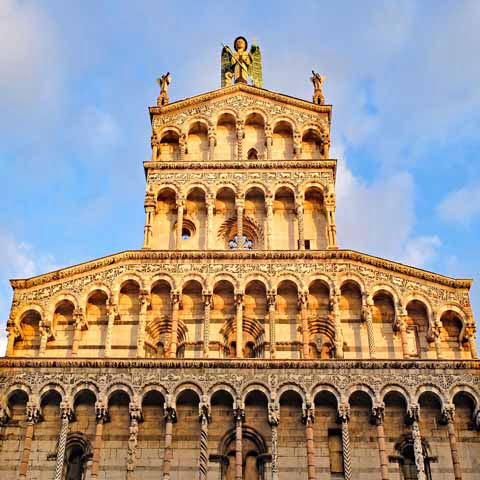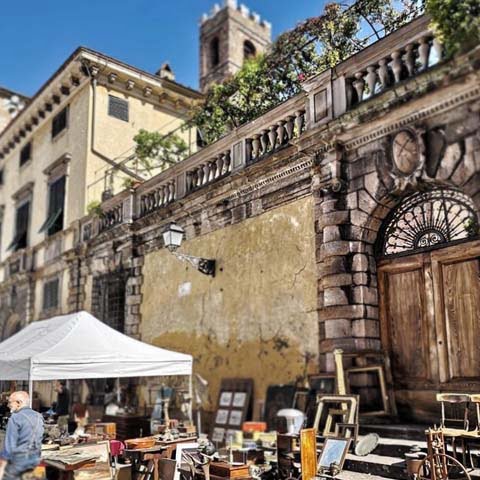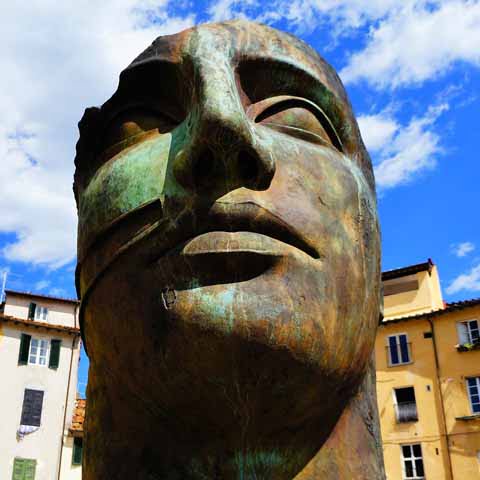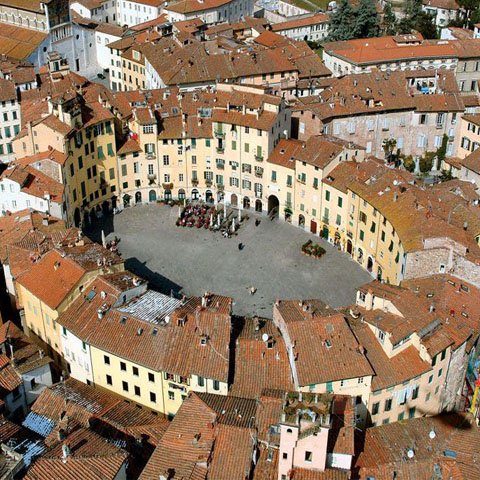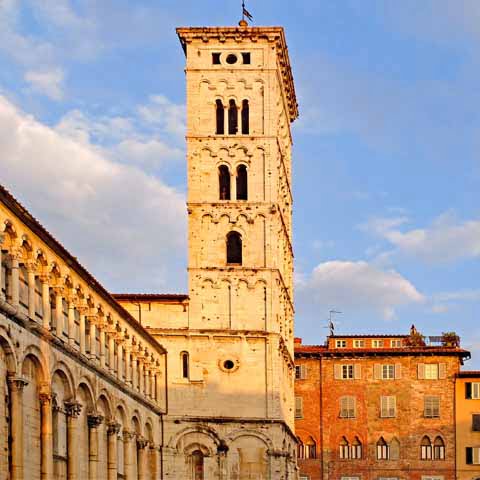Lucca was once an important Roman city that eventually thrived during the Renaissance. Surrounded by historic Renaissance walls, Lucca features ample art, architecture, and cultural sites. Whether visiting as a day trip from Florence or spending a few days in town, a trip to Lucca to explore its wide cultural offerings is an excellent way to immerse in characteristic Tuscan charm.
ART IN LUCCA
Known as the “City of 100 Churches”, there are countless locales throughout Lucca where travelers can see historic pieces of art. One of the most striking is the Lucca Cathedral, which is home to a stunning sculpture by Jacopo della Quercia entitled Monumento funebre a Ilaria del Carretto as well as beautiful paintings, such as Madonna in trono col Bamino e Santi by Domenico Ghirlandaio and Ultima Cena by Tintoretto. Along with the various artworks throughout the city’s churches, there are several museums to explore.
The National Museum of Palazzo Mansi, held within a luxurious palace, contains 83 paintings. Just a few of the artists’ works featured in the museum include Domenico di Pace Beccafumi, Paolo Veronese, Jacopo da Pontormo, Giorgio Vasari, and Agnolo Bronzino. In addition to paintings, the museum contains a collection of antique looms, costumes, and a weaving lab.
The National Museum of Villa Guinigi is one of Lucca’s richest art collections. The works displayed within it represent Lucca’s artistic development from the Middle Ages to the eighteenth century. It also contains an archaeological section which features ancient sculptures, ceramics, and gold pieces from the city and surrounding areas.
In the city’s Duomo is the Cathedral Museum, a complex which displays artifacts and pieces from the ancient days of the Duomo, including cloths, choir books, paintings, silverware, and more.
In addition to historic artwork, Lucca is home to Lu.C.C.A, the Lucca Center of Contemporary Art. Located in Palazzo Boccella, the center features five floors of modern art, a contemporary bookshop, and a lounge which features temporary exhibits.
Lucca was also the birthplace of artist Benedetto Brandimarte. The late-Renaissance painter was mainly active in the Liguria region, and is best known for his paintings in Genoa’s Church of San Benedetto. Within the province of Lucca, it is possible to admire the artist’s Lapidazione di Santo Stefano in the town of Capannori.
ARCHITECTURE IN LUCCA
Lucca is a fantastic city for those interested in architecture. Throughout it are countless churches, palazzi, towers, and Renaissance and Gothic structures to explore.
By far, the most notable architectural feature of Lucca are the Renaissance walls which surround it. Built in the 1500s, the walls encircle the city and feature unique walking paths that offer excellent views of the city. Along the walls there are two gates, or doorways, that are well-preserved.
The Church of San Michele in Foro is an eleventh-twelfth century church that was built on the location of an even older church from the eighth century. The church is made of limestone and evokes the spirit of Lucca’s architecture. It contains one nave, two aisles, and priceless works of art. Following a restoration in the nineteenth century, the façade was enriched with sculptural statues of influential historical figures, such as Dante, Garibaldi, and Count Camillo Benso di Cavour.
Lucca’s Duomo is characterized by Romanesque and Gothic architectural styles. It was originally a much simpler structure built in the sixth century. Over the years, it underwent transformations and was consecrated by Pope Alexander in the eighth century. It features a façade that dates to the early 1200s, a vaulted ceiling, and works of art by artists such as Matteo Civitali. The façade features a statue of Saint Martin of Tours, the cathedral’s namesake. The cathedral’s façade is also considered to be a more complex version of that of San Michele.
The Basilica of Saint Frediano was built in the twelfth century. The façade is white limestone and features a beautiful and ornate mosaic of Christ being carried by angels and two Apostles. It is one of the original Lucca churches. Some of its key architectural aspects are one naïve, two aisles, a colonnade which crosses the entire church, and a semi-circular apse. Among its architecture, the Basilica houses many important works of art such as Jacopo della Quercia masterpieces and works by Francesco Francia.
A very unique architectural feature of Lucca is its one-of-a-kind Piazza Anfiteatro. This inimitable location consists of an array of buildings that were built on the site of an ancient Roman amphitheater. While the amphitheater no longer exists, some parts still stand and the buildings, cafés, and restaurants were built following the distinct semi-circular shape of the amphitheater. The square is a center for cultural events and activities.
Another must-see is Torre delle Ore, which is the city’s tallest tower. The tower dates back to the fourteenth century, and eighteenth-century renovations added a modern mechanism to the tower. Travelers to Lucca must climb to 207 steps to the top of the tower where the best panorama of the city and the surrounding area can be admired.
The city of Lucca and the surrounding countryside feature beautiful villas complete with immense gardens. Travelers can admire the stately rooms and grand halls, then spend time among the exotic plants, fountains, and statues in the gardens. Several of the villas are renowned for their Renaissance architecture. A few examples include Villa Bernardini in Vicopelago, Villa Mansi in Capannori, Villa Grabau in San Pancrazio, Villa Reale in Capannori, and Villa Torrigiani of Camigliano.
LITTERATURE
Not far from Lucca proper, Bagni di Lucca is a town that was heralded as a meeting spot for famous writers and poets. In fact, English poet Percy Shelley wrote “The Baths of Lucca” about the town. During the nineteenth century the town drew in such famed writers and poets such as Lord Byron, Robert Browning, Giosuè Carducci, Charles Lever, Vincenzo Monti, Eugenio Montale, and more.
Lucca was also the focus of a poem by famed Italian poet Gabriele D’Annunzio as part of a collection of poems entitled Elettra.
MUSIC
Music is a key aspect of Lucca’s culture. The city is the birthplace of famed opera composer Giacomo Puccini, the last in a long line of musicians in the Puccini family. Born in 1858, Puccini would go on to compose some of the world’s greatest and most famous operas, including Madame Butterfly, Tosca, and La bohème.
His fifteenth century home, Casa di Puccini, has been transformed into a museum that celebrates Puccini’s life, work, and legacy. The home is located in the Piazza della Cittadella, where there is a bronze statue of the composer in the center of the square. In the Puccini house museum there are many pieces of memorabilia from the famous composer’s career, including sheet music, letters, drafts of early work, photos, costumes from his operas, and more.
To honor Puccini, there is an annual summer Puccini Opera festival held in Lucca each July and August.
Other music-focused events held in Lucca include the Opera Season at the Teatro del Giglio, the Sagra Musicale Lucchese – an array of religious and classical concerts throughout the city, and the Lucchese September Festival – an event that includes festivals of jazz, pop, and classical music.
Additionally, other musicians born in Lucca include Luigi Boccherini, Alfredo Catalani, Francesco Geminiani, and Gioseffo Guami.
CINEMA
Lucca was notably used for a filming location for the 1995 film Portrait of a Lady as well as the Mauro Bolognini film from 1958 called Giovani Mariti. Other movies filmed in Lucca or the surrounding province, at least in part, include La provinciale (1953), Per le antiche scale (1975), L’innocente (1976), Finalmente la felicità (2011), and Miracle at St. Anna (2008).
SCIENCE IN LUCCA
Lucca is home to the Academy of Sciences, dating back to 1584. It is the most famous of the city’s several academies and libraries. Lucca is also home to IMT Lucca, a research institution and graduate school.
Among Lucca’s citizens, one scientist by the name of Vincenzo Lunardi stands out. Lunardi piloted the first manned flight over England in a hot air balloon. He made subsequent flights in Scotland, Italy, Spain, and Portugal. Other important scientists that were also Lucca natives include the engineer Felice Matteucci, physician Antonio Vallisneri, and medieval surgeon Hugh of Lucca.
Lucca’s stunning panoramas are matched only by the city’s vast cultural landscape. “The City of 100 Churches,” which is renowned for its Renaissance charm, shines brightly with its historic architecture, breathtaking artwork, and literary legacy.
Don't just see Italy, live it.
Your dream trip to Italy has never been closer
No more endlessly scrolling travel sites. Our travel experts will craft the perfect, one-of-a-kind trip just for you.

300+
DESTINATIONS
We offer more Italian destinations than any travel site. Do and see more with Trips 2 Italy.
1 (of a kind)
ITINERARIES
Because your dream trip to Italy should be designed for you, not for the masses.
100%
PEACE OF MIND
From flights and accommodations, to food and activities - we take care of every detail.

